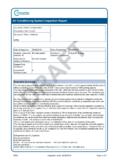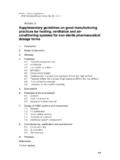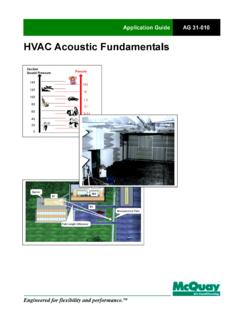Transcription of GOOD MANUFACTURING PRACTICES FOR HEATING, …
1 Working document February 2018 Draft document for comment 1 2 GOOD MANUFACTURING PRACTICES FOR HEATING, VENTILATION 3 AND AIR- conditioning SYSTEMS FOR NON-STERILE 4 PHARMACEUTICAL DOSAGE FORMS: PART 2 5 6 INTERPRETATION OF PART 1 GMP FOR HVAC SYSTEMS 7 8 (February 2018) 9 DRAFT FOR COMMENT 10 11 12 13 14 15 World Health Organization 2018 16 All rights reserved. 17 This draft is intended for a restricted audience only, the individuals and organizations having received this draft. The 18 draft may not be reviewed, abstracted, quoted, reproduced, transmitted, distributed, translated or adapted, in part or in whole, 19 in any form or by any means outside these individuals and organizations (including the organizations' concerned staff and 20 member organizations) without the permission of the World Health Organization.
2 The draft should not be displayed on any 21 website. 22 Please send any request for permission to: 23 Dr Sabine Kopp, Group Lead, Medicines Quality Assurance, Technologies Standards and Norms, Department of Essential 24 Medicines and Health Products, World Health Organization, CH-1211 Geneva 27, Switzerland. Fax: (41-22) 791 4730; 25 email: 26 27 The designations employed and the presentation of the material in this draft do not imply the expression of any opinion 28 whatsoever on the part of the World Health Organization concerning the legal status of any country, territory, city or area or 29 of its authorities, or concerning the delimitation of its frontiers or boundaries. Dotted lines on maps represent approximate 30 border lines for which there may not yet be full agreement. 31 The mention of specific companies or of certain manufacturers products does not imply that they are endorsed or 32 recommended by the World Health Organization in preference to others of a similar nature that are not mentioned.
3 Errors 33 and omissions excepted, the names of proprietary products are distinguished by initial capital letters. 34 All reasonable precautions have been taken by the World Health Organization to verify the information contained in this 35 draft. However, the printed material is being distributed without warranty of any kind, either expressed or implied. The 36 responsibility for the interpretation and use of the material lies with the reader. In no event shall the World Health 37 Organization be liable for damages arising from its use. 38 This draft does not necessarily represent the decisions or the stated policy of the World Health Organization. 39 40 Should you have any comments on the attached text, please send these to Dr S. Kopp, Group Lead, Medicines Quality Assurance, Technologies Standards and Norms with a copy to Mrs Xenia Finnerty by 26 April 2018. Medicines Quality Assurance working documents will be sent out electronically only and will also be placed on the Medicines website for comment under Current projects.
4 If you do not already receive our draft working documents please let us have your email address (to and we will add it to our electronic mailing list. Working document page 2 41 SCHEDULE FOR THE PROPOSED ADOPTION PROCESS OF DOCUMENT : 42 GOOD MANUFACTURING PRACTICES FOR HEATING, VENTILATION AND AIR-43 conditioning SYSTEMS FOR NON-STERILE PHARMACEUTICAL DOSAGE 44 FORMS: PART 2 45 46 INTERPRETATION OF PART 1 GMP FOR HVAC SYSTEMS 47 48 49 Preparation of document by Dr A. J. van Zyl, consultant January February 2018 Circulation of working document for public consultation February 2018 Consolidation of comments received and review of feedback May 2018 Discussion during the informal consultation on GXPs for medicines and inspection tools July 2018 Circulation of working document for public consultation August 2018 Consolidation of comments received and review of feedback September 2018 Presentation to the 53rd meeting of the WHO Expert Committee on Specifications for Pharmaceutical Preparations 22 26 October 2018 Any further action.)
5 Working document page 3 BACKGROUND 50 The World Health Organization (WHO) published the first edition of the WHO Guidelines on 51 good MANUFACTURING PRACTICES for heating, ventilation and air- conditioning systems for non-52 sterile pharmaceutical dosage forms in WHO Technical Report Series, No. 937, in 2006. 53 Having considered various comments and the recommendations through public consultation 54 over several years, the WHO Expert Committee on Specifications for Pharmaceutical 55 Preparations (ECSPP) agreed during its 51st meeting held in October 2017, that the Good 56 MANUFACTURING PRACTICES for heating, ventilation and air- conditioning systems for non-sterile 57 pharmaceutical dosage forms guidelines, as amended, be adopted as Part 1. 58 It was agreed that Part 1 consists of guidelines that contain good MANUFACTURING PRACTICES 59 (GMP) recommendations for heating, ventilation and air- conditioning (HVAC) systems for 60 non-sterile products, and further agreed that Part 1 be supported by an additional document 61 that reflects the interpretation of the recommendations in Part 1.
6 62 This document is Part 2 and will be considered for adoption as such after consultation. 63 64 Working document page 4 Contents 65 page 66 Section 1 and 2. Introduction and Scope 67 3. Glossary 68 4. Premises 69 5. Design of HVAC systems and components 70 6. Full fresh air and recirculation systems 71 7. Air filtration, airflow direction and pressure differentials 72 8. Temperature and relative humidity 73 9. Dust, vapour and fume control 74 10. Protection of the environment 75 11. Commissioning 76 12. Qualification 77 13. Maintenance 78 79 Working document page 5 Section 1 and 2 : Introduction and Scope 80 81 This document represents Part 2 of the HVAC systems guidelines. It contains non-binding 82 examples, drawings, technical representations and interpretation in support of Part 1 of the 83 HVAC systems guidelines. 84 85 It is intended to be a basic and explanatory guide for use by pharmaceutical manufacturers 86 and GMP inspectors.
7 It is not intended to be prescriptive in specifying requirements and design 87 parameters but it attempts to facilitate a harmonized understanding of expectations for HVAC 88 systems for manufacturers of non-sterile products. 89 90 Part 1 and Part 2 focus on good PRACTICES for HVAC systems for non-sterile products. Where 91 applicable, some of the principles referred to may be considered in the HVAC design and 92 approach for other dosage forms. These two documents are, however, not intended to be used 93 as enforceable criteria for the design or review of HVAC systems for, APIs or sterile 94 products. 95 96 Other relevant national and international standards, as applicable, should be considered when 97 Part 1 and Part 2 are used. These include, but are not limited to, the current publications such 98 as ISO 14644 and ASHRAE standards. 99 100 In general, HVAC systems can play an important role in facilitating a suitable environment 101 for the manufacture of quality pharmaceutical products.
8 Therefore careful consideration should 102 be given to the design of the HVAC system . When designing an HVAC system , careful 103 consideration should also be given to the building design and layout of areas as these may 104 influence the decision and design relating to, for example, the number of air handling units 105 (AHUs), components in AHUs, room pressure, pressure differentials, pressure cascades, 106 levels of filtration, humidification, dehumidification, heating and cooling of air. These may in 107 turn have an impact on the quality of materials and products as well as the functioning of 108 equipment and instruments. 109 110 The conditions of areas should be defined and should be appropriate for the storage, 111 MANUFACTURING and use, as appropriate, for equipment, instruments, materials and products. It 112 should further ensure that comfortable conditions are maintained for operators.
9 113 114 Risk assessment 115 116 In line with the current approach in GMP, risk identification should be done for utilities such 117 as HVAC systems. A science-based, comprehensive exercise of risk assessment should be 118 used to determine risks related to possible failure of the HVAC system and AHUs (including 119 their components and subcomponents). An appropriate risk assessment tool such as failure 120 modes and effects analysis (FMEA) or fault tree analysis (FTA) should be selected. Controls 121 should be identified to eliminate the risks, or minimize the risk to an acceptable level. For 122 example, the effect of the failure of one or more AHUs in the HVAC system ; the failure of 123 Working document page 6 dust extraction systems; the failure of AHU components such as filters, heating coils, cooling 124 coils and fans should be assessed and appropriate controls should be identified and 125 implemented.
10 126 127 For more information on risk assessment, refer the current WHO guidelines on Quality risk 128 management. 129 130 Design parameters 131 132 Manufacturers should define the design parameters of the HVAC system to ensure 133 appropriate operation and functioning of the system that is needed for all the areas. Special 134 consideration should be given to the required conditions for storage and handling of materials 135 and products, equipment and instrument functioning, personnel requirements and 136 contamination control. 137 138 Section 3. Glossary 139 140 For definitions and abbreviations, see Part 1. 141 142 143 Working document page 7 Section 4. Premises 144 145 Premises design 146 147 Both the architectural design of the building and that of the HVAC system should be 148 carefully considered when attempting to achieve the general objectives of preventing 149 contamination, cross-contamination and ensuring an appropriate environment for the 150 production and control of pharmaceutical products.














